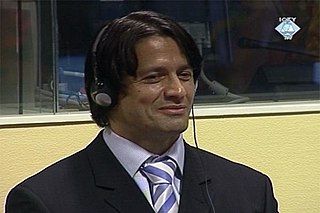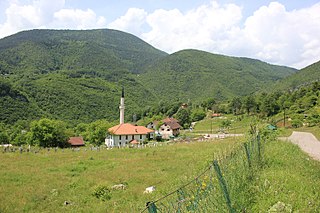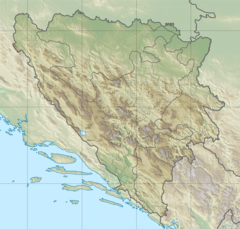
Srebrenica is a town and municipality in Republika Srpska, Bosnia and Herzegovina. It is a small mountain town, with its main industry being salt mining and a nearby spa.

Naser Orić is a former Bosnian military officer who commanded Army of the Republic of Bosnia and Herzegovina (ARBiH) forces in the Srebrenica enclave in eastern Bosnia surrounded by Bosnian Serb forces, during the Bosnian War.
Kravica is a village in Bratunac, Republika Srpska, Bosnia and Herzegovina. As of 2013 census, it has a population of 567 inhabitants.

The Bosnian War was an international armed conflict that took place in Bosnia and Herzegovina between 1992 and 1995. The war is commonly seen as having started on 6 April 1992, following a number of earlier violent incidents. The war ended on 14 December 1995 when the Dayton accords were signed. The main belligerents were the forces of the Republic of Bosnia and Herzegovina, the Republic of Herzeg-Bosnia, and the Republika Srpska, the latter two entities being proto-states led and supplied by Croatia and Serbia, respectively.

The Srebrenica massacre, also known as the Srebrenica genocide, was the July 1995 genocidal killing of more than 8,000 Bosniak Muslim men and boys in and around the town of Srebrenica, during the Bosnian War. The killings were perpetrated by units of the Bosnian Serb Army of Republika Srpska (VRS) under the command of Ratko Mladić. The Scorpions, a paramilitary unit from Serbia, who had been part of the Serbian Interior Ministry until 1991, also participated in the massacre.

The term "Bosnian genocide" refers to either the Srebrenica massacre or the wider crimes against humanity and ethnic cleansing campaign throughout areas controlled by the Army of Republika Srpska (VRS) during the Bosnian War of 1992–1995. The events in Srebrenica in 1995 included the killing of more than 8000 Bosniak men and boys, as well as the mass expulsion of another 25000–30000 Bosniak civilians by VRS units under the command of General Ratko Mladić.

The Republika Srpska was a self-proclaimed statelet in Southeastern Europe under the control of the Army of Republika Srpska during the Bosnian War. It claimed to be a sovereign state, though this claim was only partially recognized by the Bosnian government in the Geneva agreement, the United Nations, and FR Yugoslavia. For the first six months of its existence, it was known as the Serbian Republic of Bosnia and Herzegovina.

Radislav Krstić is a former Bosnian Serb Deputy Commander and later Chief of Staff of the Drina Corps of the Army of Republika Srpska from October 1994 until 12 July 1995. He was promoted to the rank of major general in June 1995 and assumed command of the Drina Corps on 13 July 1995.

Skelani is a village in the municipality of Srebrenica, in the Republika Srpska entity of Bosnia and Herzegovina.

Žepa is a village located in the municipality of Rogatica, Republika Srpska, Bosnia and Herzegovina. As of 2013 census, it has a population of 133 inhabitants. It is situated northeast of Rogatica itself on the banks of short river with a same name, the Žepa river, which flows into the Drina river nearby, in a valley between the mountains Javor and Devetak.

The Višegrad massacres were acts of mass murder committed against the Bosniak civilian population of the town and municipality of Višegrad during the ethnic cleansing of eastern Bosnia by Republika Srpska police and military forces during the spring and summer of 1992, at the start of the Bosnian War.

The Lašva Valley ethnic cleansing, also known as the Lašva Valley case, refers to numerous war crimes committed during the Bosnian war by the Croatian Community of Herzeg-Bosnia's political and military leadership on Bosniak or Bosnian Muslim civilians in the Lašva Valley region of Bosnia-Herzegovina. The campaign, planned from May 1992 to March 1993 and erupting the following April, was meant to implement objectives set forth by Croat nationalists in November 1991. The Lašva Valley's Bosniaks were subjected to persecution on political, and religious grounds, deliberately discriminated against in the context of a widespread attack on the region's civilian population and suffered mass murder, rape and wartime sexual violence, imprisonment in camps, as well as the destruction of religious and cultural sites and private property. This was often followed by anti-Bosniak propaganda, particularly in the municipalities of Vitez, Busovača, Novi Travnik and Kiseljak.

The siege of Srebrenica was a three-year siege of the town of Srebrenica in eastern Bosnia and Herzegovina which lasted from April 1992 to July 1995 during the Bosnian War. Initially assaulted by the Yugoslav People's Army (JNA) and the Serbian Volunteer Guard (SDG), the town was encircled by the Army of Republika Srpska (VRS) in May 1992, starting a brutal siege which was to last for the majority of the Bosnian War. In June 1995, the commander of the Army of the Republic of Bosnia and Herzegovina (ARBiH) in the enclave, Naser Orić, left Srebrenica and fled to the town of Tuzla. He was subsequently replaced by his deputy, Major Ramiz Bećirović.

On 12 April 1993, the Army of Republika Srpska (VRS) launched an artillery attack against the town of Srebrenica, in eastern Bosnia, which left 56 dead and 73 seriously wounded, among whom were 14 children dead in a school playground. The attack came following the suspension of cease-fire talks, hours before NATO would implement a no-fly zone according to an UN resolution. VRS officials had previously told UNHCR representatives that the VRS would shell the town within two days unless it surrendered.
The Kravica massacre was one of the mass executions of Bosniaks by the Army of Republika Srpska during the Srebrenica massacre. It was committed on 14 July, 1995. It is estimated that between 1,000 and 1,500 men were killed.
The Zaklopača massacre occurred three years before the Srebrenica massacre, at the time when Serb forces were committing a campaign of ethnic cleansing of the Bosniak civilians in the Srebrenica region. According to Helsinki Watch at least 83 Bosniaks were killed, including 11 children and 16 elderly persons. According to the Institute for the Research of Genocide, Canada:
On 16 May 1992, Serb forces approached the village and demanded Bosniak residents to hand over their weapons. Except few hunting rifles, Bosniak residents did not have any combat weapons to defend themselves. When the Serbs learned that the residents were effectively unarmed, they blocked all exists of the village and massacred at least 63 Bosniak men, women and children.
The Glogova massacre was the mass murder of 64 Bosniak civilians by Serb forces, consisting of the Yugoslav People's Army (JNA), Bratunac Territorial Defence (TO), local police, and paramilitaries from Serbia, on 9 May 1992. Miroslav Deronjić, the head of the "Bratunac Municipal Board" established by the Serbian Democratic Party (SDS), was sentenced to 10 years in prison by the International Criminal Tribunal for the former Yugoslavia for ordering the massacre.
The Skelani massacre refers to the Army of the Republic of Bosnia and Herzegovina (ARBiH) attack on Skelani, group of villages in region of Srebrenica, Bosnia and Herzegovina, held by Army of Republika Srpska (VRS), which happened on 16 January 1993. Between 40-65 Serbs were killed in the attack.
On 12 July 1992, a total of 69 Bosnian Serb soldiers and civilians were killed in the villages of Zalužje and Sase in the municipality of Srebrenica, and Biljača and Zagoni in the municipality of Bratunac, after an attack by the Army of the Republic of Bosnia and Herzegovina (ARBiH). It occurred during the Bosnian War.













